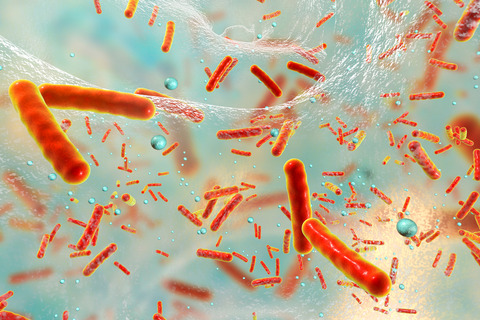New findings on antibiotic resistance (ABR) and faecal pollution along the entire course of the Danube have been published. Researchers from the Karl Landsteiner University of Health Sciences and the ICC Water & Health* are in charge.
Krems (Austria), 08. May 2024: Two new scientific studies to understand the spread of antibiotic resistance (ABR) along the Danube have produced important key findings: Biofilms present in the river may be better indicators than the water itself of the entry of antibiotic-resistant bacteria from clinical facilities and wastewater. In addition, a new investigative concept – combining molecular genetic methods for ABR detection with modern diagnostics for faecal pollution and key environmental and chemical parameters – has shown that human faecal contamination is the main source of ABR along the entire Danube. The new approach allows the spatio-temporal dynamics of ABR in rivers to be recorded, hotspots to be identified and the main drivers of ABR to be determined.
Every year, thousands of people in Europe die from infections caused by antibiotic-resistant bacteria. These are alarming figures, partly due to the development of resistance caused by the overuse of antibiotics in medicine and agriculture. Globally, the ‚clinical environment‘ (e.g. hospitals) is considered to be the main hotspot for the spread and development of ABR, as this is where antibiotic-resistant bacteria or their genes are exchanged between patients. Clinical wastewater enters natural aquatic ecosystems via sewage treatment plants, allowing ABR bacteria to enter rivers and lakes. There they are not only found in the water itself, but also in biofilms – communities of microorganisms that adhere to solid surfaces in the water, such as rocks, plants or sediments, producing a common layer of mucus (extracellular matrix) and thus form a stable “film”.
Resistance Patterns of E. coli in Human and River Samples
In one of the current studies, the research team analysed the resistance patterns of the bacterium Escherichia coli in human isolates and environmental samples from the Danube (water and biofilm) with partners from the University Hospital St. Pölten (Prim. Dr. Barbara Ströbele, Dr. Ildiko Pap), teaching and research site of KL Krems, and the Medical University of Graz (Doz. Dr. Gernot Zarfel). Prof. Andreas Farnleitner, Head of the ICC Water and Health* at KL Krems and TU Vienna, explains: „E. coli is a very suitable model organism for this: it is widespread as the main pathogen of urinary tract infections, often colonises leaking urinary catheters of hospital patients, is used in water as an indicator of ABR and is recommended by the WHO as an indicator of antibiotic resistance. In total, we analysed 697 patient, 489 water and 440 biofilm isolates for their sensitivity to 20 antibiotics and thus obtained resistance patterns.” Overall, the results indicated a rather moderate resistance situation in Austria: despite significantly higher resistance levels in the human isolates compared to the river samples, only few resistances to common reserve antibiotics such as meropenem and tigecycline – drugs that are only used when first-line therapy is ineffective – were found. Although there were no major differences in resistance between water and biofilm samples, some bacterial isolates were found in the biofilm that were resistant to certain critical antibiotics and even carried ESBL genes. ESBL stands for “extended-spectrum beta-lactamase” and means that these bacteria produce enzymes that are resistant to many beta-lactam antibiotics, which makes the treatment of infections more difficult. The biofilm may therefore be a better indicator of the influence of clinical environments on ABR in rivers than the water itself.
A Comprehensive Understanding of the ABR Along 2,300 km of the Danube River
Large rivers are particularly critical ecosystems for the global distribution of ABR in the environment because they can be heavily affected by wastewater pollution and at the same time represent vital lifelines that fulfil various human needs. However, a comprehensive understanding of the occurrence, distribution and main drivers of ABR along entire river courses has so far been largely lacking – a fact that the researchers addressed in the other study for the Danube. They chose a holistic approach by analysing spatio-temporal patterns and hotspots of antibiotic-resistant genes (ARGs) along 2,311 km of the navigable Danube river and combining a longitudinal and temporal surveillance campaign. Prof Alexander Kirschner, researcher at MedUni Vienna, Karl Landsteiner University Krems and deputy head of the ICC, comments: “The extensive expertise gained in this way forms the basis for targeted management to reduce the spread of ABR in river basins. We are presenting the first in-depth ARG dataset along the Danube, which will help to assess future trends.” To improve the understanding of the distribution and dynamics of ABR, ABR should also be investigated in other environmental compartments – such as river biofilms or sediments – as these could serve as long-term reservoirs.
Images available on request.
Copyright Picture: AdobeStock/Dr_Microbe
Original Publications: A comparative study on antibiotic resistant Escherichia coli isolates from Austrian patients and wastewater-influenced Danube River water and biofilms. International Journal of Hygiene and Environmental Health 258 (2024) 114361. Melanie Leopold, Angelika Kabicher, Ildiko-Julia Pap, Barbara Ströbele, Gernot Zarfel, Andreas H. Farnleitner, Alexander K.T. Kirschner. https://kris.kl.ac.at/de/publications/a-comparative-study-on-antibiotic-resistant-escherichia-coli-isol
Linking antibiotic resistance gene patterns with advanced faecal pollution assessment and environmental key parameters along 2300 km of the Danube River. Water Research 252 (2024) 121244. Iris Schachner-Groehs, Michael Koller, Melanie Leopold, Claudia Kolm, Rita B Link, Stefan Jakwerth, Stoimir Kolarevi, Margareta Kracun-Kolarevic, Wolfgang Kandler, Michael Sulyok, Julia Vierheilig, Marwene Toumi, Rozsa Farkas, Erika Toth, Clemens Kittinger, Gernot Zarfel, Andreas H Farnleitner, A.K.T. Kirschner. https://kris.kl.ac.at/de/publications/linking-antibiotic-resistance-gene-patterns-with-advanced-faecal-
Contribution to PhD training: Melanie Leopold and Iris Schachner-Groehs will obtain their PhD degrees as part of this study and research collaboration between KL Krems, TU Vienna and MedUni Vienna.
Karl Landsteiner University of Health Sciences (05/2024)
The Karl Landsteiner University of Health Sciences (KL Krems) is an educational and research institution on the Campus Krems and recognised throughout Europe. KL Krems offers modern, demand-oriented education and continuing education in medicine and psychology as well as a PhD programme in Mental Health and Neuroscience. The flexible educational programme is tailored to the needs of students, the requirements of the labour market and the challenges of science. The three university hospitals in Krems, St. Pölten and Tulln and the MedAustron Ion Therapy and Research Centre in Wiener Neustadt guarantee clinical teaching and research of the highest quality. In its research, KL Krems focuses on interdisciplinary fields with high relevance to health policy – including biomechanics, molecular oncology, mental health and neuroscience as well as the topic of water quality and the associated health aspects. KL Krems was founded in 2013 and accredited by the Austrian Agency for Quality Assurance and Accreditation (AQ Austria).
*The ICC Water & Health is a cooperation between TU Wien, Medical University of Vienna and Karl Landsteiner University of Health Sciences (www.waterandhealth.at). The Inter-University Cooperation Center for Water and Health (ICC Water & Health) sees itself as a scientific platform and competent partner in questions of water quality and its impact on human health. The ICC is dedicated to the development of innovative concepts for assessing water quality, new microbiological and molecular biology methods, efficacy testing of physical and chemical treatment methods, and numerical models for estimating the risk of infection and disease in water use. The lessons learned will be used to derive effective and sustainable health management measures. The ICC was founded by the Vienna University of Technology and the Medical University of Vienna in 2010 and has been sustainably established thanks to the competitive research funding of the Federal Ministry of Science, Research and Economy (BMWFW). In 2017, ICC Water & Health was expanded to include the Karl Landsteiner University of Health Sciences (KL). KL is now an official part of the research platform.
Scientific Contact
Prof. Andreas Farnleitner
Prof. Alexander Kirschner
Water Quality and Health Division
Karl Landsteiner University of Health Sciences
Dr.-Karl-Dorrek-Straße 30
3500 Krems an der Donau / Austria
T +43 664 605 88 22 44
+43 2732 72090 394
E andreas.farnleitner@kl.ac.at,
alexander.kirschner@kl.ac.at
W https://www.kl.ac.at/, www.waterandhealth.at
Karl Landsteiner University of Health Sciences
Eva-Maria Gruber
Communications, PR & Marketing
Dr.-Karl-Dorrek-Straße 30
3500 Krems / Austria
T +43 2732 72090 231
M +43 664 5056211
E evamaria.gruber@kl.ac.at
W https://www.kl.ac.at/
Copy Editing & Distribution
PR&D – Public Relations for Research & Education
Dr. Barbara Bauder
Kollersteig 68
3400 Klosterneuburg / Austria
M +43 664 1576 350
E bauder@prd.at
L https://www.linkedin.com/company/prd-public-relations-für-forschung-bildung

